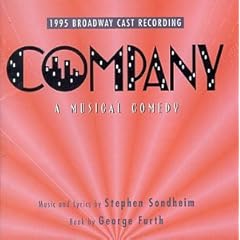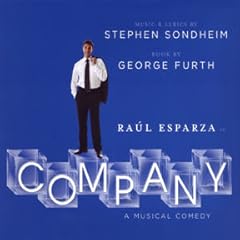
Company
Alvin Theatre: April 26, 1970 - January 1, 1972 (Original Broadway Production)
Vivian Beaumont Theatre: April 11, 1993 - April 12, 1993 (Special Revival Production)
Criterion Center Stage Right: October 5, 1995 - December 3, 1995 (Revival Production)
Ethel Barrymore Theatre: November 29, 2006 - July 1, 2007 (Revival Production)



Original Broadway Cast (Alphabetical):
Barbara Barrie as Sarah
Charles Braswell as Larry
Susan Browning as April
George Coe as David
John Cunningham as Peter
Steve Elmore as Paul
Beth Howland as Amy
Dean Jones as Robert
Charles Kimbrough as Harry
Merle Louise as Susan
Donna McKechnie as Kathy
Pamela Myers as Marta
Teri Ralston as Jenny
Elaine Stritch as Joanne
Opening Night: 2006 Revival
On The Scene: Raúl Esparza and the Company of Company Celebrate a New CD
Being Bobby
Song List:
Act 1
Overture
Company
The Little Things You Do Together
Sorry-Grateful
You Could Drive a Person Crazy
Have I Got A Girl for You
Someone Is Waiting
Another Hundred People
Getting Married Today
Marry Me a Little*
Act 2
Side by Side by Side/What Would We Do Without You?
Poor Baby
Tick-Tock**
Barcelona
The Ladies Who Lunch
Being Alive
Synopsis:
The clashing sounds and pulsing rhythms of New York City underscore this landmark "concept" show, considered by many to have inaugurated the modern era of musical theatre. “Company” follows our anti-hero bachelor Robert as he makes his way through a series of encounters with April (the stewardess), Kathy (the girl who's going to marry someone else), Marta (the "peculiar" one), as well as with his married friends.
On the night of his 35th birthday, confirmed bachelor Robert contemplates his unmarried state. In vignette after hilarious vignette, we are introduced to "those good and crazy people," his married friends, as Robert weighs the pros and cons of married life. In the end, he realizes being alone is "alone, not alive."
An honest, witty, sophisticated look at relationships, “Company” is as contemporary and relevant as ever (witness the recent hit revivals on Broadway and the West End). It features a brilliant energetic score containing many of Sondheim's best-known songs (including "Another Hundred People," "The Ladies Who Lunch" and "Being Alive") and an ensemble of quirky, memorable Woody Allen-esque characters which doubles as the show's chorus. This, in addition to the unit set and modest orchestra size, makes “Company” a great show for intimate stages or groups with a limited budget.
Reviews:
British director John Doyle found an unusual and different way of staging Stephen Sondheim's musical Sweeney Todd, cutting it down to a minimum and having the actors double as musicians. After starting out regionally in Great Britain, his version earned a well-received Broadway production in 2005. He took the same approach with a second Sondheim musical, Company, a year later, and this one too came to New York, 11 years after the first Broadway revival of the 1970 show. If anything, the approach works even better than it did with Sweeney Todd. The show has 14 characters, which means that the new orchestrations by Mary-Mitchell Campbell don't have to be that small, but then Company's music doesn't need a big orchestra, mixing as it does pop styles with elements of vaudeville razzmatazz. As was true of Doyle's Sweeney Todd, the effect of having the actors double as musicians is largely a theatrical one that doesn't translate to the cast album. There are exceptions to this, for instance the saxophone trio that sings and plays "You Could Drive a Person Crazy," with the saxes substituting for some of the original Andrews Sisters-like harmonies. But to a large extent, on disc, this Company is just another one to add to the two previous Broadway and two London cast recordings, the main difference being that it is about eight and a half minutes longer than the original Broadway cast album by virtue of the inclusion of "Marry Me a Little," a song cut from the first production that was added into the 1995 revival and is retained here, and a considerable amount of dialogue (written by librettist George Furth) that gives a better sense of how the songs work in the show. The cast is led by Raúl Esparza in the part of Bobby, the 35-year-old New York bachelor struggling with issues of romantic commitment while interacting with his married friends and his girlfriends. Esparza sings emotionally and well, and he is matched by the other 13 performers. The original Broadway cast album of Company has yet to be bettered, in part because it continues to seem a definitive treatment of the score. This version is also very good and offers some slight differences to recommend it. ~ William Ruhlmann, All Music Guide
Fire flickers, dangerous and beckoning, beneath the frost of John Doyle’s elegant, unexpectedly stirring revival of “Company,” which opened last night at the Ethel Barrymore Theater. This visually severe, aurally lush reinvention of Stephen Sondheim and George Furth’s era-defining musical of marriage and its discontents from 1970 is the chicest-looking production on Broadway. One glance at the symmetry, the starkness, the midnight-black palette that dominates the stage, and you feel like putting on a sweater. It’s surely no coincidence that the clear modules that serve as furniture resemble ice cubes. What could be more appropriate for a musical with a passive, willfully unengaged leading man (wearing black Armani, natch), who is almost never seen without a defensive drink in his hand? But if Bobby the bachelor, embodied with riveting understatement by Raúl Esparza, at first comes across as a man of ice, it becomes apparent that he is in a steady state of thaw. Given the subliminal intensity that hums through Mr. Esparza’s deadpan presence, you sense that flood warnings should probably be posted. Mr. Doyle is the inspired British director who last year gave New York the most unsettling, emotionally concentrated production on record of another Sondheim musical, the macabre “Sweeney Todd.” In that show, for which Mr. Doyle won a Tony Award, the cast members doubled as musicians, a device repeated in this “Company.” This “I-am-my-own-orchestra” approach probably shouldn’t be used ad infinitum. Mr. Doyle applied the same stratagem to Jerry Herman’s “Mack and Mabel” in London last summer to underwhelming effect. But there’s something about Mr. Sondheim that allows Mr. Doyle to find a new clarity of feeling through melding musicians and performers. It is, after all, the person who controls the music in a Sondheim production — in which there is usually a sophistication gap between the songs and the relatively pedestrian book — who has the best chance of finding the show’s elusive but resonantly human heart. Mr. Doyle’s “Company,” first staged at the Cincinnati Playhouse earlier this year, isn’t the unconditional triumph that his “Sweeney Todd” was, partly because the show itself is less of a fully integrated piece and partly because much of the acting is weaker. Only a few of the 14 ensemble members — playing the couples who are permanent fixtures in Bobby’s life and his strictly temporary girlfriends — seem at ease dispensing Mr. Furth’s brittle, uptown, shrink-shrunk dialogue. But they all blossom as musicians and singers of wit and substance. As soloists they’re more than adequate, but it’s their work as a team that sounds new depths in “Company” in ways that get under your skin without your knowing it. Mr. Doyle and his invaluable music supervisor and orchestrator, Mary-Mitchell Campbell, have shaped “Company” into a sort of oratorio for the church of the lonely. The choral passage that opens the show — a litany of variations on Robert (a k a “Bobby, baby”), the name of the central character, about to celebrate his 35th birthday — is performed in near darkness a cappella, sounding like liturgical chant. The effect is not flippant. The voices — belonging to “those good and crazy people, my married friends”— seem to echo through Bobby’s head like elements of some beautiful but arcane ritual that he can observe only from a distance. Watching is what Bobby does. His outsider’s status is confirmed with pointed eloquence when it registers that Bobby is the only person onstage who isn’t playing an instrument. The production gets astonishingly diverse theme- and character-defining mileage out of this discrepancy. Bobby’s failure to pick up an instrument and join the band becomes a natural-born metaphor for his refusal to engage with others. Yes, he sings soulfully. But as the other cast members circle the lone Mr. Esparza, playing their instruments, it is clear they possess talents for connecting that Bobby lacks, fears and longs for. Watching the couples carp and bicker in black-out vignettes — practicing karate, experimenting with pot, visiting a discothèque — you may wonder why Bobby would ever be envious of them (which has always been a problem with “Company”). It’s when they make music together that you understand. Mr. Doyle’s staging repeatedly and ingeniously echoes this isolating difference. Mr. Esparza is often found climbing onto the top of a Steinway or one of those transparent cubes as others crowd him. Sometimes he stands at a skeptical, uneasy remove as different groups serenade him: the married men with the haunting “Sorry-Grateful”; three girlfriends, all playing saxophones as if they were assault weapons, in a scintillating version of “You Could Drive a Person Crazy.” The seamlessness of these motifs lends a fresh coherence to “Company,” which was originally structured as a cabaret of urban neurosis. Stand-alone crowd pleasers like “Getting Married Today” (performed by a too-grounded-seeming Heather Laws as the skittish Amy) and “Another Hundred People” (warmly sung by Angel Desai) now blend into a general musical fabric of anxiety in search of reassurance. Even the fabled character number, “The Ladies Who Lunch,” sung by the worldly, much-married Joanne (a fierce Barbara Walsh), feels less like a show-stopping appendage than it usually does. Instead, building to a climactic repeated note that suggests what Edvard Munch’s silent scream might sound like, it becomes the perfect preface to Bobby’s breakthrough breakdown at the end of the show. If Ms. Walsh doesn’t erase the memory of Elaine Stritch, who created (and will probably always own) the part, she handles her vodka-stinger-flavored dialogue with a vintage Manhattan suaveness, which is more than can be said for many of the others. Bruce Sabath, though, is touching and credible as Joanne’s patient husband. And Elizabeth Stanley is absolutely delicious as April, the ditzy airline stewardess, who sings “Barcelona” (the best one-night-stand song in musicals). The sense that ambivalence and confusion are not unique to Bobby is enhanced by the cold, austere glitter of David Gallo’s set and Thomas C. Hase’s superb lighting. But it’s Mr. Esparza who is the top expert on ambivalence here, giving “Company” the most compelling center it has probably ever had. In previous productions, Bobby has registered principally as a wistful window onto other lives. But Mr. Esparza is anything but a cipher. Though his Bobby can seem as laconic and drolly unresponsive as Bob Newhart, you are always aware that this is a man in pain. As anyone who saw him in “Cabaret” or “The Normal Heart” knows, Mr. Esparza is generally a pyrotechnic actor, sending sparks and smoke all over the place. In keeping the lid on such volcanic energy, he makes Bobby’s climactic explosion inevitable. Though he sings beautifully throughout — in ways that define his character’s solipsism — he brings transporting ecstasy to the agony of the concluding number, in which Bobby finally joins the band of human life. For much of Mr. Sondheim’s career, directors have approached his work as if “keep your distance” were woven into the copyright. More recently, a new generation of artists have heard an altogether different directive: “Come closer.” Mr. Doyle and Mr. Esparza make it clear that there are infinite rewards to be had in accepting that challenge. ~ New York Times
There may be no original Broadway cast recording more iconic than 1970's Company, with its funky organ sound and Elaine Stritch's not-quite-there high notes, but the December 2006 Broadway revival makes its own mark. For Stephen Sondheim and George Furth's piece about a single man observing the benefits and follies of marriage, director John Doyle borrows the same controversial concept he used for his 2005 Sweeney Todd: the actors playing instruments on stage (now referred to in many circles as "Doyle-izing," and not always with affection and delight). But when you're listening to a cast recording, as Bobby would say: What do you get? For one thing, you'll have to adjust to some different sounds created by Doyle and his music supervisor, Mary-Mitchell Campbell. It's a benefit in "Side by Side by Side," which begins with a jazzy double-bass line. It's a drawback in "You Could Drive a Person Crazy," in which the trio's doo-doots are replaced by their saxophone lines. You also get "Marry Me a Little," cut from the original show but by now very familiar and welcome, as well as a lot of the contextual dialogue before, between, and even within numbers. Finally, the strong cast led by Raul Esparza makes this the best-sung Company we've ever gotten (and they play very well too), and Stephen Sondheim's score is still a landmark in musical theater. There will never be a replacement for the original Broadway cast recording, but this revival recording can stand on its own and in some respects may be more flat-out enjoyable to listen to. --David Horiuchi
Other Productions:
1. The first U.S. national tour opened on May 20, 1971 at the Ahmanson Theatre in Los Angeles with George Chakiris as Bobby, and closed exactly one year later at the National Theatre in Washington, D.C..
2. The first West End production opened on January 18, 1972 at Her Majesty's Theatre, Haymarket, where it ran for 344 performances. The original cast included Larry Kert, Elaine Stritch, and Donna McKechnie; Dilys Watling and Julia McKenzie were replacements later in the run.
3. After 43 previews, the 1995 Roundabout Theatre revival, directed by Scott Ellis and choreographed by Rob Marshall, opened on October 5, 1995 at the Criterion Center Stage Right, where it ran for 60 performances. The cast included Boyd Gaines, Kate Burton, Robert Westenberg, Diana Canova, Debra Monk, LaChanze, Charlotte d'Amboise, Jane Krakowski, and Veanne Cox.
4. The 1995 London revival was directed by Sam Mendes. Previews began at the Donmar Warehouse on December 1; the show opened on December 13 and closed on March 2, 1996. Previews began at the Albery Theatre on March 7; it opened on March 13 and closed on June 29. The cast included Adrian Lester as the first black Bobby in a major production of the show. A videotaped recording was broadcast by BBC 2 on March 1, 1997.
5. A Brazilian production opened on February 8, 2001 at the Villa-Lobos Theatre in Rio De Janeiro, closed April 22, opened April 27 at the Alfa Theatre in São Paulo, then returned to the Villa-Lobos Theatre in Rio, where it still is running.
6. A Kennedy Center production, presented as part of a summer-long salute to Sondheim, opened on May 17, 2002 for a 17-performance run. Directed by Sean Mathias, the cast included John Barrowman, Emily Skinner, Alice Ripley, and Lynn Redgrave.
7. A new revival had try-outs at the Cincinnati Playhouse in the Park's Robert S. Marx Theatre in the spring of 2006. After 34 previews, the Broadway revival, directed and choreographed by John Doyle (who helmed the revival of Sondheim's Sweeney Todd in 2005), opened on November 29, 2006 at the Ethel Barrymore Theatre with a cast that included Raúl Esparza as Bobby. The musical closed on July 1, 2007, and also was taped for possible presentation on Public television. [8] As in Doyle's 2006 Broadway production of Sweeney Todd, the actors themselves provided the orchestral accompaniment. The production won the Tony Award for Best Revival of a Musical.
Awards & Nominations:
Original 1971 Broadway Production (20 Nominations, 12 Wins)
1971 Tony Awards:
Best Musical WINNER
Best Book of a Musical WINNER
Best Original Score WINNER
Best Lyrics WINNER
Best Actor in a Musical (Kert)
Best Actress in a Musical (Stritch and Browning)
Best Featured Actor in a Musical (Kimbrough)
Best Featured Actress in a Musical (Barrie and Myers)
Best Scenic Design WINNER
Best Lighting Design
Best Choreography
Best Direction of a Musical WINNER
Theatre World Award (Browning) WINNER
Drama Desk Award for Outstanding Book WINNER
Drama Desk Award for Outstanding Lyrics WINNER
Drama Desk Award for Outstanding Music WINNER
Drama Desk Award for Outstanding Set Design WINNER
Drama Desk Award for Outstanding Director WINNER
1995 Broadway Revival (3 Nominations)
1995 Tony Awards:
Best Revival of a Musical
Best Featured Actress in a Musical (Veanne Cox)
1995 Drama Desk Awards:
Outstanding Featured Actress in a Musical (Veanne Cox)
2006 Broadway Revival (8 Nominations, 4 Wins)
2007 Tony Awards:
Best Revival of a Musical WINNER
Best Performance by a Leading Actor in a Musical (Raúl Esparza)
Best Direction of a Musical (John Doyle)
2007 Drama Desk Awards:
Outstanding Revival of a Musical WINNER
Outstanding Actor in a Musical (Raúl Esparza) WINNER
Outstanding Featured Actress in a Musical (Barbara Walsh)
Outstanding Director of a Musical (John Doyle)
Outstanding Orchestrations (Mary-Mitchell Campbell) TIE
* The song "Marry Me a Little" was cut from the original score but was restored permanently in the 1990s to close Act I. Added to the 1995 and 2006 revivals, it is also included in the official composer's edition of the vocal selections, published in 1996.
** The dance number "Tick-Tock" (arranged by David Shire) was abridged for the first Broadway revival, and afterwards deleted entirely from the score. It had become a liability in productions without dancers of the caliber of Donna McKechnie.</center>
---------------------------------------------------------
Previous Discussions:
Beauty and the Beast
Bye Bye Birdie!
Wicked